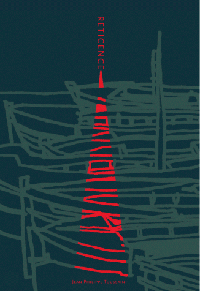 RETICENCE
RETICENCE
by Jean-Philippe Toussaint
Dalkey Archive, Reprint 2012
104 pages / $12.95 Buy from Dalkey Archive or Amazon
Jean-Philippe Toussaint is a novelist who, in his initial success with publication, was often grouped alongside other novelists which many critics were considering the “post-nouveau roman writers,” writers who had, persumably, grown up reading the New Novel authors during their formative years while the New Novels were the pinnacle of literature in France. They were often marked by a return to a more, shall we say, straight-forward narrative, a return to character, but still displayed a marked attention to everything that the New Novel broke down.
It is, perhaps, not surprising then, that upon reading Toussaint’s short novel Reticence, I couldn’t help but think of Alain Robbe-Grillet’s seminal The Voyeur, published over 40 years before Toussaint’s novel (released in France in 1991, though just seeing English translation in 2012). While Toussaint’s novel avoids the fetishization & perversion that’s present “between the lines” of Robbe-Grillet’s novel (something that was seemingly never remarked upon by the author whom Barthes’ claimed wrote purely objectively), Toussaint’s novel also seems to be a detective novel which, similar to Robbe-Grillet’s novel, may or may not be missing the crime in its entirety, recalled only obliquely–recalled? or invented out of a reticence?
Reticence talls the tale of a man who visits Saseulo with his infant son to visit his friends, the Biaggis. However, the longer he fails to actually visit the Biaggis, the more and more hesitation he develops, until he begins to believe that M Biaggi himself may be watching him in secret. Has something else happened? The novel leaves holes, an obliquity, that allows the reader to decide for herself what has happened (similar, of course, to Robbe-Grillet’s novel, in which the protagonist is never, with any validity, objectively suggested as the perpetrator of the violent rape and murder of a young girl). In Toussaint’s novel the dailiance is more minor, though there might be a murder involved, whether of a black cat or M. Biaggi.
While there is a remarkable similarity between the two novels, both on the level of plot and structure (the books are both broken into 3 sections and take place in very small towns that the protagonist have visited before, where the coast and fishermen play arguably large roles), I suppose what’s important, really, is authorial intent, and I’d insist that Toussaint’s intent–though clearly hyper-aware that he’s paying homage to Robbe-Grillet–is markedly different from Robbe-Grillet, who in the 50s had an entirely different program than simply writing ‘good novels.’
An element that marks a majority of Toussaint’s novels–at least those that I personally have encountered–is a uniquely hyperbolic way of filling pages and pages with minutiae without creating an oppressive space of boredom. Edouard Leve achieves a similar effect in his brilliant Suicide, but while Leve is distancing the reader from the heaviness offered upon the novel’s first page, Toussaint’s distance is more of a stylistic choice, a sort of anti-camp that creates humor in an oddly similar fashion to that of hyperbole.
Regardless, the novel reads quick and is exciting in its developments, and the brief stutters of repetition that repeat and question the reality of the narrative’s diegesis play a fun headtrip on the reader.
Tags: Dalkey, Impossible Mike, Jean-Philippe Toussaint, RETICENCE

You forget to mention how funny Toussaint is. Camera is a great example.
http://fullmalls.net/ g